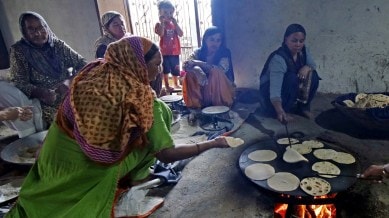Stay updated with the latest - Click here to follow us on Instagram
Women lead in Punjab flood relief: Embankments to camps & supplies
Across Punjab’s flood-hit districts, thousands of women endure similar conditions but have still stepped out of their homes to help.

On the bridge over the Beas connecting Hoshiarpur and Tanda, 32-year-old Harmel Kaur has been living in a makeshift camp for 20 days, turning a trolley into a cramped room and kitchen for her three children, after floodwaters submerged her home and fields. “The morning and evening meals come from the gurdwara. I still make tea, wash clothes and do all the chores, even though there is no toilet here. We have to go out in the open,” she says, boiling milk on a small gas stove.
Then, Harmel pauses and adds, “For women, this is much harder than for men. But this is a calamity, and we have to bear it.”
monthly limit of free stories.
with an Express account.
Across Punjab’s flood-hit districts, thousands of women endure similar conditions but have still stepped out of their homes to help. They are the unseen volunteers ferrying medicines to marooned hamlets, setting up kitchens in trolleys, and working shoulder to shoulder with men to hold the flood at bay.
They are also the hygiene warriors. “We formed a small team, raised everything through donations from Chandigarh and Mohali, and took relief to the Ramdas–Ajnala belt,” says Harpuneet Kaur, a law student at Panjab University. “Sanitary pads are the most basic need. Many families didn’t even have undergarments. This is causing UTI issues. Women with severe period pain are unable to manage without hot water or home care.”
Her team now focuses on medical support and cleanliness drives. “Because of waterlogging, fungal infections and allergies are common,” she says, as volunteer doctors consult on the spot. “Rations are reaching big hubs, what’s missing is hygiene. That’s what we’re prioritising now,” says Harpuneet.
The massive floods that hit Punjab in mid-August, fuelled by heavy rains and water release from dams upstream, have claimed 48 lives and displaced over 3.54 lakh people, with 21,000 evacuated to relief camps. More than 1,900 villages across all 23 districts have been inundated, submerging 3.71 lakh acres of farmland.
With some respite from rains expected from Monday, the Punjab government has ordered schools across the state, which have remained shut since August 27, to reopen from Tuesday after inspection.
Mansa-based kabaddi player Pittu Kotra started “with just a bag of clothes” and is now leading a convoy of volunteers, taking medicines by boat to homes cut off in Sultanpur Lodhi. “We cannot give up. Punjab lives in the heart, we must come together,” she says.
Singer Baani Sandhu has issued an Instagram appeal for tailors around Mohali to stitch 1,000 salwar suits for displaced women, focusing on dignity and comfort for pregnant women.
Actor Zainab Rajput Sai’s team has spent 10 days distributing essential items, wading through chest-deep water without life jackets. “Many times, boats have no diesel or drivers,” she says. “From the administration, even basic safety gear hasn’t reached us.”
In Gondwana village in Amritsar, a large group of NREGA women workers has mobilised to fill sandbags and reinforce river embankments. Balwinder Kaur, one of them, says the rising water entered her home and damaged her rooftop. She joined the effort not only for employment but also to protect her house. “Community volunteers bring sand, and we fill the bags. These are then deployed along weak points in the bunds,” she says.
With authorities selecting NREGA women workers to fill the bags while locals collectively built up embankments, residents described this initiative as one of the few government-supported measures in the area.
Midday meal worker Mohinder Kaur has been on round-the-clock duty at a government-run relief camp at Baupur in Sultanpur Lodhi, coordinating food and water arrangements for women sheltering there, even as she lost her grain to the floods. Stationed at the camp, she oversees meals and supplies. Ensuring dignity and safety for women, she offers sleeping space in her home whenever the camp gets full.
Wherever relief kitchens have sprung up, women are at the core. Many have turned their tractors and trolleys into rolling kitchens, cooking dal and rotis not just for their families but for the other flood-hit and those repairing embankments. At night, these trolleys serve as beds, too.